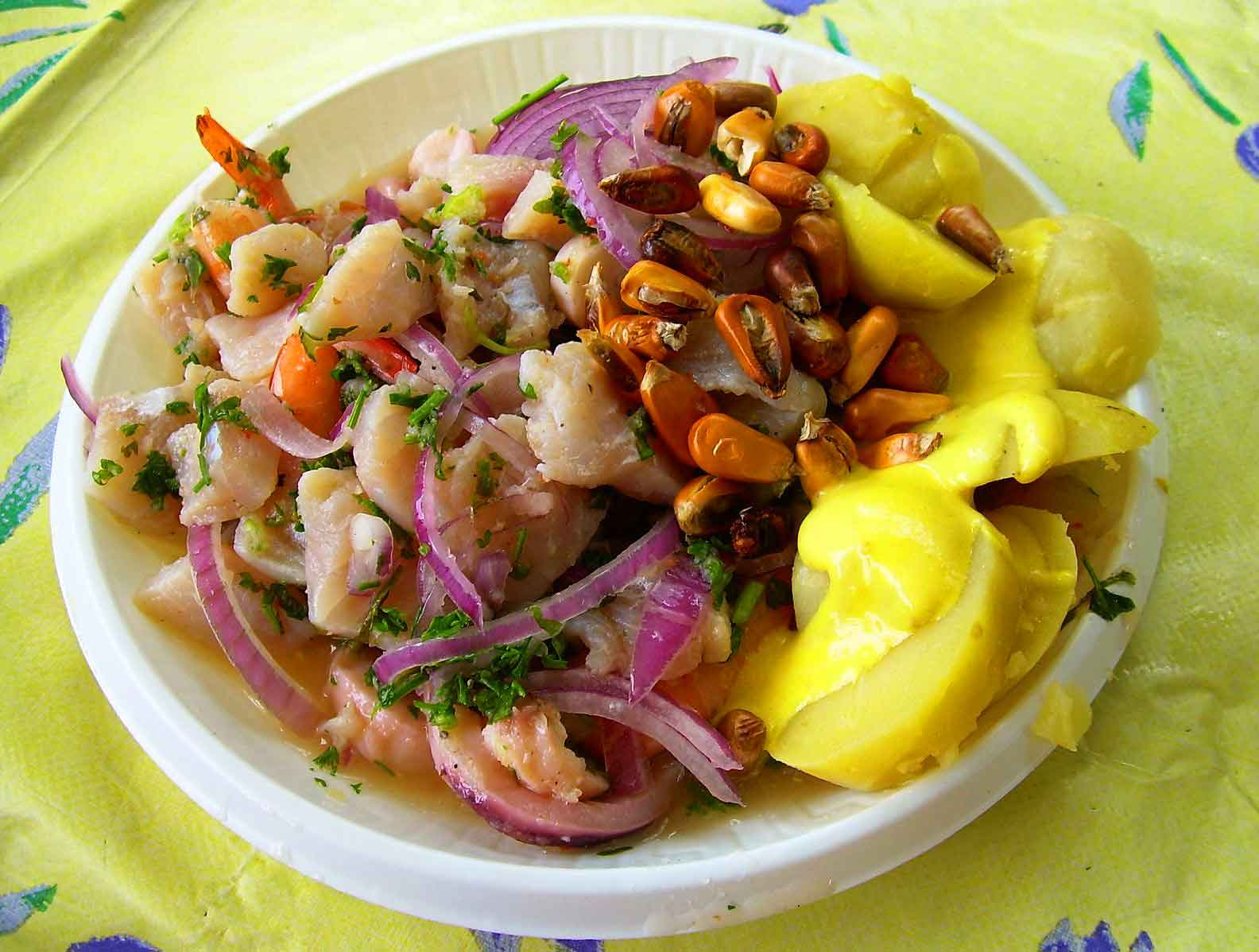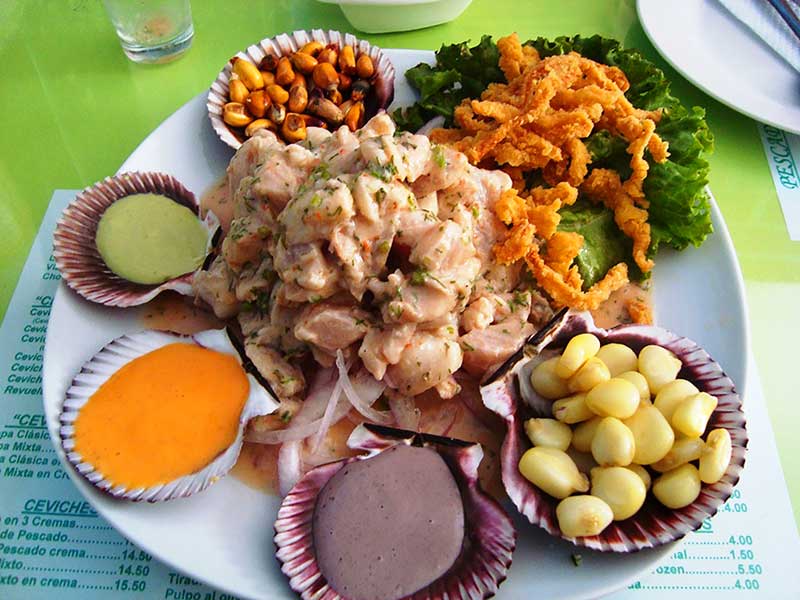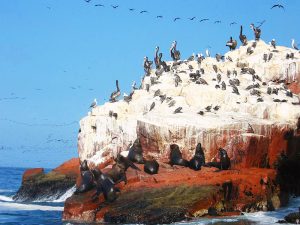Ceviche (Peru) is a traditional dish with roots tracing back to the Inca civilization. It has evolved over centuries and has come to incorporate influences from Spanish and Japanese cuisine. Ceviche is recognized as Peru’s national dish and holds cultural importance. It even has its own holiday: National Ceviche Day is June 28th.
The dish consists of fresh raw fish marinated in lime juice, which naturally “cooks” the fish through acid denaturation. Essential ingredients include red onions, chili peppers, salt, and sometimes cilantro. Sweet potatoes, corn, and plantain chips usually accompany it.
In this article, we’ll go over everything you need to know about Ceviche, including the history, where to eat the best Ceviche, and more.
Table of Contents
Everything You Need To Know About Ceviche (Peru)
What Is Ceviche?
Ceviche is a popular seafood dish made from raw fish or seafood marinated in citrus juice, usually lime or lemon. The acid in the citrus juice denatures the proteins in the fish, giving it a cooked texture without using heat.
It is commonly seasoned with salt, chili peppers, and fresh herbs like cilantro. While variations exist across Latin America, Peruvian ceviche is considered the most authentic and influential as it’s known for its fresh, bold flavors, Ceviche is a staple of coastal cuisine worldwide.
The History Of Ceviche (Peru)
Ceviche dates back to the pre-Columbian era, with origins linked to the Inca civilization in present-day Peru. The Incas preserved fish using salt and fermented juice from local fruits. When Spanish colonizers arrived in the 16th century, they introduced citrus fruits like limes, replacing the traditional fermentation process. Over time, Ceviche evolved with influences from Spanish and Japanese immigrants, who slowly changed the ingredients over hundreds of years.
Is Ceviche Safe To Eat?
Ceviche is generally safe to eat when prepared with fresh, high-quality seafood and proper food handling. The acidic citrus juice helps kill some bacteria and parasites, but it does not eliminate all risks like traditional cooking methods, so please bear this in mind if you have a weak stomach.
To reduce the risk of illness, always confirm the Ceviche is made with sushi-grade fish and consumed immediately after preparation. People with weakened immune systems, pregnant women, and those sensitive to raw seafood should exercise caution or avoid consuming Ceviche if necessary. Proper refrigeration and sourcing seafood from reputable suppliers reduces the risk of foodborne illnesses, too.

Where To Eat Ceviche In Lima
Lima is known as the culinary capital of South America, so it’s truly the best place for foodies to experience authentic Ceviche. The city offers a variety of options, no matter your budget. Here are a few options to consider:
La Mar Cebichería
A world-famous seafood restaurant by chef Gastón Acurio and with great reviews, it’s well known for its fresh, high-quality ceviche.
Pescados Capitales
With excellent reviews and unique decor, Pescados Capitales offers creative variations of Ceviche with a focus on Peruvian flavors and fresh ingredients.
El Mercado
A trendy spot by chef Rafael Osterling, this restaurant offers a strong menu, serving some of the best seafood dishes in Lima.
Canta Rana
Canta Rana is much more casual than the other restaurants listed. It’s a local favorite known for its generous portions and chic atmosphere, and is one of many awesome things to do when in Barranco.
Punto Azul
A popular choice among locals, Punto Azul offers classic Ceviche with traditional Peruvian flavors. This is the most authentic option on the list.

Frequently Asked Questions About Ceviche Peru
Let’s now take a look at some of the most frequent questions we get asked about Ceviche (Peru) and how to have the best experience possible when trying this delightful national dish.
What Is Ceviche (Peru) Made Of?
Peruvian Ceviche is made with fresh raw fish, typically white fish like sea bass or flounder, marinated in freshly squeezed lime juice. It is then mixed with red onions, salt, and ají chili peppers, often served with a side of sweet potatoes, corn (choclo), and toasted corn (concha).
Why Is Peruvian Ceviche The Best?
Ceviche (Peru) is considered the best due to its freshness and strong flavors. Ceviche is focused on high-quality raw fish that is then cooked in freshly squeezed Peruvian limes, which are more acidic than the limes you may find in your local grocery store. Plus, it is believed that Ceviche was born here, so it only makes sense that Peruvian Ceviche would be the best!
How Is Peruvian Ceviche Eaten?
Peruvian ceviche is traditionally eaten fresh and immediately after preparation so that it is safe to eat. It is served cold on a plate or in a shallow bowl, with the marinating lime juice (“leche de tigre”) often enjoyed as a flavorful broth. Ceviche is commonly enjoyed as a midday meal rather than dinner, as its acidity and freshness are considered best suited for lunch. It is often paired with a cold Pisco Sour, Inca Kola, or beer for the true experience.
Overview Of Ceviche (Peru)
Ceviche is one of Peru’s most iconic dishes, consisting of fresh raw fish marinated in lime juice, chili peppers, and salt. The acidity of the citrus juice naturally “cooks” the fish, which helps give it a firm yet tender texture.
So when visiting Peru, it’s an absolute must to try the Ceviche at least once. It’s a staple in Peru, and if you like Sushi or fish in general, you’ll likely love it. That’s, of course, if you have a strong enough stomach.
Are you looking to explore more local Peruvian dishes? When in Lima you can join our incredible food tour, where we will take you to authentic spots to try all kinds of national delights and staple dishes.




